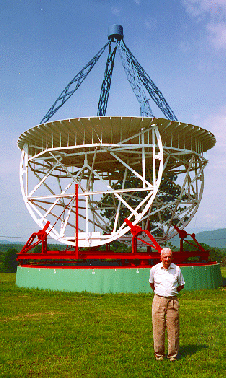
Despite the implications of Jansky’s work, both on the design of radio receivers, as well as for radio astronomy, no one paid much attention at first. Then, in 1937, Grote Reber, another radio engineer, picked up on Jansky’s discoveries and built the prototype for the modern radio tele-scope in his back yard in Wheaton, Illinois. He started out looking for radiation at shorter wavelengths, thinking these wavelengths would be stronger and easier to detect. He didn’t have much luck, however, and ended up modifying his antenna to detect radiation at a wavelength of 1.87 meters (about the height of a human), where he found strong emissions along the plane of the Milky Way.

Reber’s Radio Telescope
Reber continued his investigations during the early 40s, and in 1944 published the first radio frequency sky maps. Up until the end of World War II, he was the lone radio astronomer in the world. Meanwhile, British radar operators during the war had detected radio emissions from the Sun. After the war, radio astronomy developed rapidly, and has become of vital importance in our observation and study of the universe.